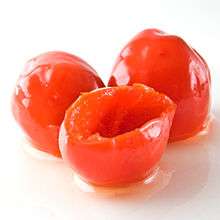Peppadew
| Peppadew | |
|---|---|
 Processed peppadew peppers | |
| Species | Capsicum baccatum |
| Cultivar | piquanté |
| Marketing names | peppadew |
| Origin | South Africa |
| Heat |
|
| Scoville scale | 1,177[1] SHU |
Peppadew is the trademarked brand name of sweet piquanté peppers (a cultivar of Capsicum baccatum) grown in the Limpopo province of South Africa.
History
This type of piquante pepper was first discovered in early 1993[1] and introduced to market later that same decade. The name is a portmanteau of 'pepper' and 'dew'. Although the pepper is sometimes described as a cross between a pepper and a tomato, this description is not botanically accurate, and refers only to the resemblance in color and size between peppadew and cherry tomatoes.
Applications have been made by the various owners of the brand to secure international breeders' right by application to the UPOV.[2][3]
In 2000, South African mushroom producer, Denny Mushrooms, acquired the Peppadew brand and business.[4][5] Denny has in turn since been acquired by AVI.[6]
Processing
The fruit is processed for removal of the seeds and reduction of the heat of the pepper to more pleasant levels. It is then pickled and bottled.
Flavour
The flavour of the Peppadew fruit is sweet, with mild heat of around 1200 SHU on the Scoville scale.[1]
See also
References
- 1 2 3 "US PVP Application Number 9800051 - Solanaceae Capsicum Annuum Pepper (Chili) "Juanita"" (PDF). United States Department of Agriculture. 1997-12-30. Retrieved 2009-04-26.
- ↑ "'Peppadew' syn Steenkam" (PDF). Plant Varieties Journal. 10 (3): 17–18. 1997. ISSN 1188-1534. Archived from the original (PDF) on 12 February 2014. Retrieved 2009-04-26.
- ↑ "Government Gazette No 32004". South African Government. 13 March 2009. p. 13. Archived from the original on 4 June 2011. Retrieved 2009-04-26.
- ↑ Myriam Velia; Imraan Valodia (2003). Assessing some Core Characteristics of the DTP (PDF). Research Report No 56. University of Natal. p. 28. ISBN 1-86840-495-1.
- ↑ "Wie is die pappa van Peppadews?" (in Afrikaans). News24. 2004-02-10. Retrieved 2009-04-26.
- ↑ "Audited results for the year ended 30 June 2005" (PDF). AVI. 2005-09-07. p. 2. Retrieved 2009-04-26.